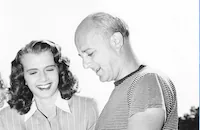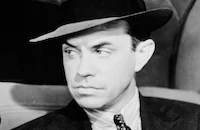Pacific Liner

Brief Synopsis
Cast & Crew
Lew Landers
Victor Mclaglen
Chester Morris
Wendy Barrie
Alan Hale
Barry Fitzgerald
Film Details
Technical Specs

Synopsis
Crusher McKay, the tough engineer aboard the passenger ship the S.S. Arcturus , is both beloved and feared by his men. Also onboard the ship is Doc Tony Craig, who has signed on the San Francisco bound trip in Shanghai to be near his former sweetheart, nurse Ann Grayson. Crusher is also attracted to the nurse, and his clumsy courtship creates a rivalry between him and Doc. In mid-ocean, a Chinese stowaway infected with cholera is discovered below decks and panic breaks out. After Crusher orders the doors bolted to the decks above, Doc, who is trying to prevent the spread of the disease, clashes with Crusher, who is battling to keep his men at the task of firing the ship's boilers. Meanwhile, above decks, the passengers are blissfully unaware of the terror below as one by one the crew are stricken with the dread disease. Ann and Doc, thrown together in their struggle to save the men, rekindle their love, and Doc resolves to give up his wanderlust for Ann. As more men fall ill, Crusher takes up the shovel to stoke the engines day and night until he, too, is stricken. In Crusher's absence, the men's morale plummets, pushing them to mutiny. While Doc tries to stave off the mutiny, Crusher rises from his bed to force his men back to work, and guided by Crusher's determination, the S.S. Arcturus safely reaches port.

Director

Lew Landers
Cast

Victor Mclaglen

Chester Morris

Wendy Barrie

Alan Hale

Barry Fitzgerald
Allan Lane

Halliwell Hobbes

Cyrus W. Kendall

Paul Guilfoyle

John Wray
Emory Parnell
Adia Kuznetzoff
John Bleifer
Crew
Russell Bennett
Anthony Coldeway
Albert D'agostino
Lee Marcus
Harry Marker
Nicholas Musuraca
Van Nest Polglase
Sam Ruman
Darrell Silvera
Robert Sisk
Edward Stevenson
Henry Roberts Symonds
Douglas Travers
John E. Tribby
John Twist
Vernon L. Walker

Videos
Movie Clip



Film Details
Technical Specs

Award Nominations
Best Score
Articles
Pacific Liner
The passenger list alone in Pacific Liner includes some of the most distinguished and memorable character actors of the thirties and forties - Alan Hale, Barry Fitzgerald, Allan Lane, Paul Guilfoyle, Cy Kendall and Halliwell Hobbes. It's just one reason this disaster-at-sea flick remains an obscure favorite amongst movie buffs. But every ship needs an experienced seaman, and Victor McLaglen, who played enough "Old Salts" to qualify for a maritime pension, fit the role like a glove.
Soldier of fortune, prizefighter, circus strongman and Wild West show performer, McLaglen, the son of the one-time Bishop of Claremont in South Africa, landed his first movie role on a lark in The Call of the Road (1920). Well received, this began his stint as a star in British silents before arriving in America, where he appeared in the first versions of The Unholy 3 (1925) and Beau Geste (1926). He soon became a popular leading man, working for Howard Hawks (A Girl in Every Port, 1928) and, most notably, John Ford, who guided him through a number of popular vehicles including The Informer (1935), wherein the surprised star copped the year's Best Actor Oscar. McLaglen rode out the 1930s by settling into boisterous, tough-as-nails character parts, making him a natural for the role of Crusher McKay in Pacific Liner.
As for the film's love interest, those duties fall to Chester Morris and Wendy Barrie, respectively cast as the ship's doctor and nurse. In the brisk 77-minute narrative they manage to find time for a romance in-between combating a deadly plague and a potential mutiny aboard the ill-fated S. S. Arcturus. Morris was born into a show business family, making his film debut in a 1910 short. Oscar-nominated for his first talkie, Alibi (1929), Morris quickly became a major star of the early 30s, playing opposite such female luminaries as Norma Shearer (The Divorcee, '30) and Jean Harlow (Red-Headed Woman '32). Barrie was the godchild of famed Peter Pan author, J.M. Barrie, and first gained notice on the screen in The Private Life of Henry VIII (1933). Graced with charm and poise, her talents were nevertheless soon relegated to the RKO B-unit where she reluctantly took up residence in the Saint and Falcon detective series (Barrie, in fact, self-proclaimed herself as "the Queen of the Bs"). None of her on-camera action in crime dramas matched her tumultuous private entanglement as the girl friend and one-time fiancee of the notorious Benny "Bugsy" Siegel. Barrie's very active romantic social life often generated more publicity than her screen roles. Reading like a veritable male Who's Who of the rich and famous, the actress' myriad of suitors included A.C. Blumenthal, Tyrone Power, Howard Hughes and Fritz Lang to name a few.
In addition to a first-rate cast, Pacific Liner also had some impressive talents behind the camera. With nearly 150 feature films to his credit, director Lew Landers enjoyed the freedom of working in almost every movie genre, from uncompromising horror pictures to rough house comedies to westerns and non-stop action sagas. Best known for his official 1935 debut, The Raven, a Boris Karloff/Bela Lugosi shocker that repelled critics with its spurts of sadism and violence, this now-acknowledged 30s classic paved the way for later work like Pacific Liner which equally disturbed many reviewers for its shots of infected bodies being tossed into the stoker's ovens.
Van Nest Polglase and Albert D'Agostino, known specifically for their elegant art direction in Astaire-Rogers musicals, created a lavish shipboard set for Pacific Liner with art deco trimmings that stood out as an ironic contrast against the grim storyline. The cinematography is by Nicholas Musuraca, who specialized in moody, atmospheric black and white imagery and would later put his distinctive stamp on RKO's horror fantasies produced by Val Lewton (Cat People, 1942, The Seventh Victim, 1943). And last but not least is music composer Robert Russell Bennett who copped an Oscar nomination for Best Original Score for Pacific Liner (competing against such heavyweights as Victor Young, Alfred Newman and Franz Waxman). However, the coveted award went to maestro Erich Wolfgang Korngold for his magnificent work on The Adventures of Robin Hood.
Producer: Robert Sisk
Director: Lew Landers
Screenplay: Derek N. Twist, John Twist, story by Anthony Coldeway & Henry Roberts Symonds
Art Direction: Van Nest Polglase
Cinematography: Nick Musuraca
Costume Design: Edward Stevenson
Film Editing: Harry Marker
Original Music: Robert Russell Bennett
Principal Cast: Victor McLaglen (Crusher), Chester Morris (Dr. Craig), Wendy Barrie (Ann), Alan Hale (Gallagher), Barry Fitzgerald (Britches), Allan Lane (Bilson), Halliwell Hobbes (Captain Mathews), Cy Kendall (Deadeyes).
BW-77m.
By Mel Neuhaus

Pacific Liner
Quotes
Trivia
Notes
Music director Russell Bennett received an Academy Award nomination in the Music (Original Score) category.

Miscellaneous Notes
Released in United States 1939
Released in United States 1939













